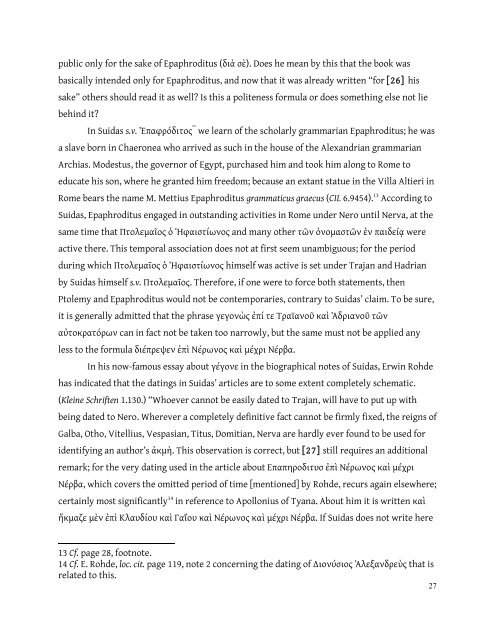The Jewish Historian Flavius Josephus: A Biographical Investigation
The Jewish Historian Flavius Josephus: A Biographical Investigation
The Jewish Historian Flavius Josephus: A Biographical Investigation
Create successful ePaper yourself
Turn your PDF publications into a flip-book with our unique Google optimized e-Paper software.
public only for the sake of Epaphroditus (διὰ σὲ). Does he mean by this that the book was<br />
basically intended only for Epaphroditus, and now that it was already written “for [26] his<br />
sake” others should read it as well? Is this a politeness formula or does something else not lie<br />
behind it?<br />
In Suidas s.v. Ἐπαφρόδιτος῎῍ we learn of the scholarly grammarian Epaphroditus; he was<br />
a slave born in Chaeronea who arrived as such in the house of the Alexandrian grammarian<br />
Archias. Modestus, the governor of Egypt, purchased him and took him along to Rome to<br />
educate his son, where he granted him freedom; because an extant statue in the Villa Altieri in<br />
Rome bears the name M. Mettius Epaphroditus grammaticus graecus (CIL 6.9454). 13 According to<br />
Suidas, Epaphroditus engaged in outstanding activities in Rome under Nero until Nerva, at the<br />
same time that Πτολεμαῖος ὁ Ἡφαιστίωνος and many other τῶν ὀνομαστῶν ἐν παιδείᾳ were<br />
active there. This temporal association does not at first seem unambiguous; for the period<br />
during which Πτολεμαῖος ὁ Ἡφαιστίωνος himself was active is set under Trajan and Hadrian<br />
by Suidas himself s.v. Πτολεμαῖος. <strong>The</strong>refore, if one were to force both statements, then<br />
Ptolemy and Epaphroditus would not be contemporaries, contrary to Suidas’ claim. To be sure,<br />
it is generally admitted that the phrase γεγονὼς ἐπί τε Τραϊανοῦ καὶ Ἁδριανοῦ τῶν<br />
αὐτοκρατόρων can in fact not be taken too narrowly, but the same must not be applied any<br />
less to the formula διέπρεψεν ἐπὶ Νέρωνος καὶ μέχρι Νέρβα.<br />
In his now-famous essay about γέγονε in the biographical notes of Suidas, Erwin Rohde<br />
has indicated that the datings in Suidas’ articles are to some extent completely schematic.<br />
(Kleine Schriften 1.130.) “Whoever cannot be easily dated to Trajan, will have to put up with<br />
being dated to Nero. Wherever a completely definitive fact cannot be firmly fixed, the reigns of<br />
Galba, Otho, Vitellius, Vespasian, Titus, Domitian, Nerva are hardly ever found to be used for<br />
identifying an author’s ἀκμὴ. This observation is correct, but [27] still requires an additional<br />
remark; for the very dating used in the article about Επαπηροδιτυσ ἐπὶ Νέρωνος καὶ μέχρι<br />
Νέρβα, which covers the omitted period of time [mentioned] by Rohde, recurs again elsewhere;<br />
certainly most significantly 14 in reference to Apollonius of Tyana. About him it is written καὶ<br />
ἤκμαζε μὲν ἐπὶ Κλαυδίου καὶ Γαΐου καὶ Νέρωνος καὶ μέχρι Νέρβα. If Suidas does not write here<br />
13 Cf. page 28, footnote.<br />
14 Cf. E. Rohde, loc. cit. page 119, note 2 concerning the dating of Διονύσιος Ἀλεξανδρεὺς that is<br />
related to this.<br />
27
















